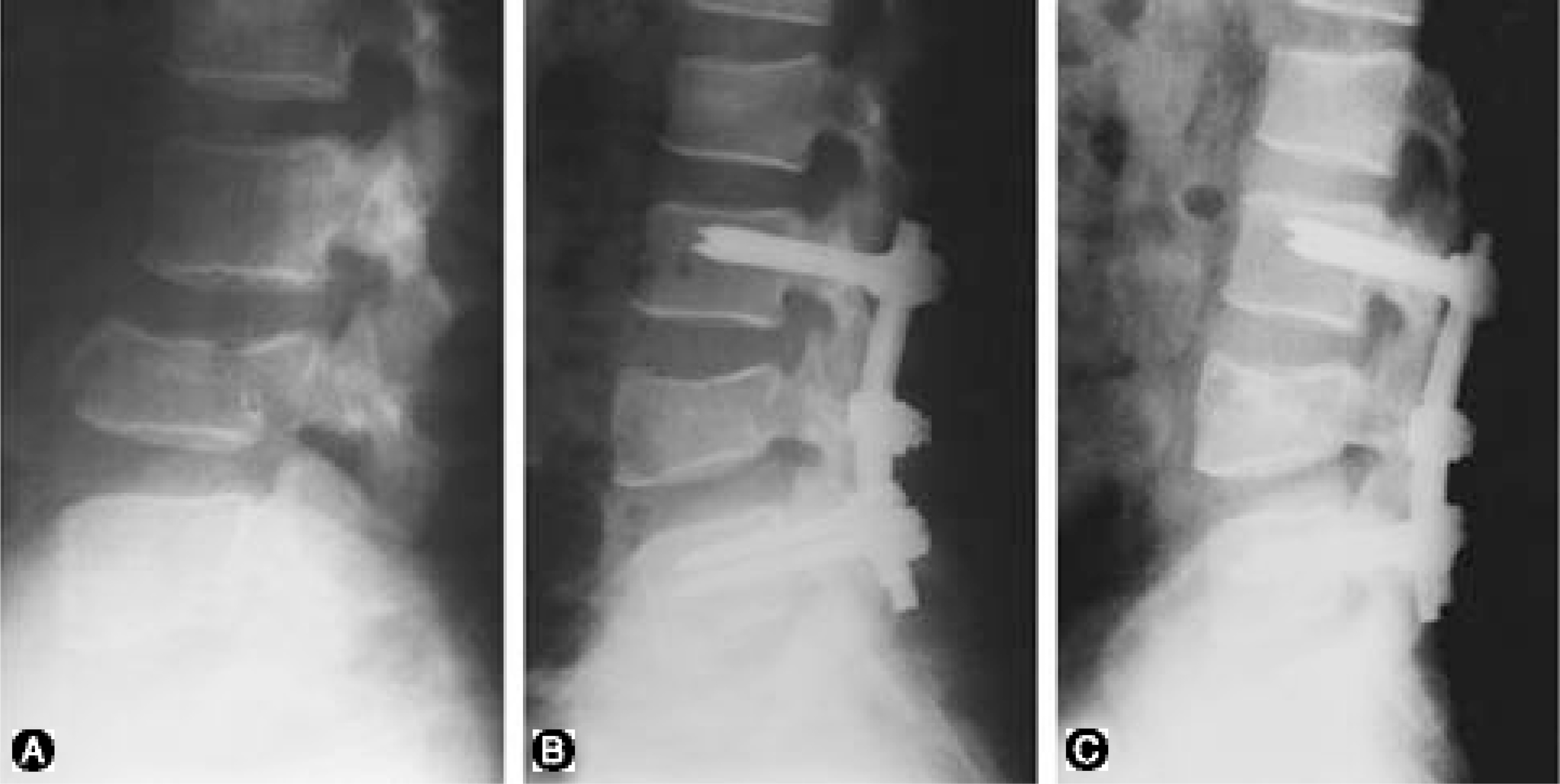J Korean Soc Spine Surg.
2002 Sep;9(3):204-210. 10.4184/jkss.2002.9.3.204.
Treatment of Posterior Facet Fracture-Dislocation in Lumbar Spine
- Affiliations
-
- 1Department of Orthopaedic Surgery, Wonju College of Medicine, Yonsei University, Wonju, Korea. par73@wonju.yonsei.ac.kr
- KMID: 2003226
- DOI: http://doi.org/10.4184/jkss.2002.9.3.204
Abstract
-
STUDY DESIGN: Retrospective study.
OBJECTIVES
The purpose of this study is to compare the outcomes of short segment fusion and long segment fusion in posterior facet fracture-dislocation in the lumbar spine. SUMMARY OF LITERATURE REVIEW: There are many controversies exist about the treatment of fracture-dislocation in lumbar spine. MATERIAL AND METHODS: Sixteen patients with lumbar fracture-dislocation were studied retrospectively. The patients divided two groups; group one treated with one level above and below the fracture segment fixation, group two treated with two level above and below the fracture segment fixation. Two groups were compared with neurologic recovery, bladder function recovery and radiologic changes of deformities.
RESULTS
The neurologic deficit in two groups was improved more than one Frankel grade at last follow up. Patients who showed intact dura were neurologically improved significantly than the patients whose dura was ruptured. Radiologic changes were not a sinificant difference in two groups.
CONCLUSION
In lumbar fracture-dislocation treatment, one level above and below the fracture segment fixed with pedicle screw fixation system was an effective treatment method which preserved the mobile segment lumbar spine.
MeSH Terms
Figure
Reference
-
1). Bohlman HH. Treatment of fracture and dislocations of the thoracic and lumbar spine. J Bone Joint Surg. 67-A:165–169. 1985.2). Chapman JR, Anderson PA. Thoracolunbar spine fractures with neurologic deficit. Orthop Clin North Am. 25:595–597. 1994.3). Choi WS, Baik CH, Cho SS, Park HJ, Koh DH. Clinical analysis of unstable thoracolumbar fractures and fracture-dislocation using transpedicular screws. J Korean Ortho Surgery. 26:719–727. 1991.4). Denis. The three column spine and it's significance in the classification of acute thoracolumbar injuries. Spine. 8:817–831. 1983.5). Denis F, Barkus JK. Shear fracture dislocation of the thoracolumbar spine associated with forceful hyperex -tension. Spine. 17:156–161. 1992.6). Denis F, Ruiz H, Searls K. Comparison between square-ended distraction rods and standard round-ended distraction rods in the treatment of thoracolumbar spinal injuries. Clin Ortho. 189:162–167. 1984.7). Dick W. Internal fixation of thoracic and lumbar spine fractures. 1st ed. Toronto: Hans Huber Co;p. 75–86. 1989.8). Dick W, Kluger P, Margel F. A new device for internal fixation of thoracolumbar and lumbar spine fracture. Paraplegia. 23:225–232. 1985.9). Dickson JH, Harrington RP, Erwin WD. Harrington instrumentation in the fractured unstable thoracic and lumbar spine. J Bone Joint Surg. 55-A:422–426. 1973.10). Edward CC, Levine AM. Early rod sleeve stabilization of the injured thoracic and lumbar spine. Orthop Clin North Am. 17:121–145. 1986.11). Farcy J, Weidenbaum M, Michelson CB, Hoeltzel DA, Athansiou KA. A comparative biomechanical study of spinal fixation using Cotrel-Dubousset instrumentation. Spine. 12:877–881. 1987.
Article12). Frankel HL, Hancock DO, Hyslop G. The value of postural reduction in the initial management of closed injuries of the spine with paraplegia and tetraplegia. Paraplegia. 7:179–192. 1969.
Article13). Gertzbein SD. Multicenter spine fractured study. Spine. 17:528–539. 1992.14). Krag MH. Biomechanics of thoracolumbar spinal fixation. Spine. 16:S84–S99. 1991.
Article15). McLain RF, Sparling E, Benson DR. Early failure of short-segment pedicle instrumentation for thoracolumbar fractures. J Bone Joint Surg. 75-A:162–167. 1993.16). Shaffrey CJ, Saffrey ME, Whitehill R, Nockels RP. Surgical treatment of thoracolumbar fractures. Neurosurgery Clin North Am. 8:519–540. 1997.
Article17). Stauffer ES. Internal fixation of fracture of the thoracolumbar spine. J. Bone Joint Surg. 66-A:1136–1138. 1984.18). Stauffer ES. Thoracolumbar spine fractures without neurologic deficit. AAOS monography series, 49-80. 1993.19). Tasdemirogle E, Tibbs PA. Longterm followup results of thoracolumbar fractures after posterior instrumentation. Spine. 20:1704–1708. 1995.
Article
- Full Text Links
- Actions
-
Cited
- CITED
-
- Close
- Share
- Similar articles
-
- Bilateral Locked Facets at Lower Lumbar Spine Without Facet Fracture: A Case Report
- Neglected Unilateral Subluxation of Facet Joint in Lumbar Spine of Multiple Trauma Patient: A Case Report
- Fracture-dislocation of L5 Combined with Multi-level Traumatic Spondylolisthesis of the Lower Lumbar Spine Treated via the Posterior-only Approach: A Case Report
- The Reduction of Locked Facet on 12 th Thoracic Vertebra with Harrington Distraction Rods
- Management of Facet Joint Fracture-Dislocation of the Lower Cervical Spine with Reduction Failure



